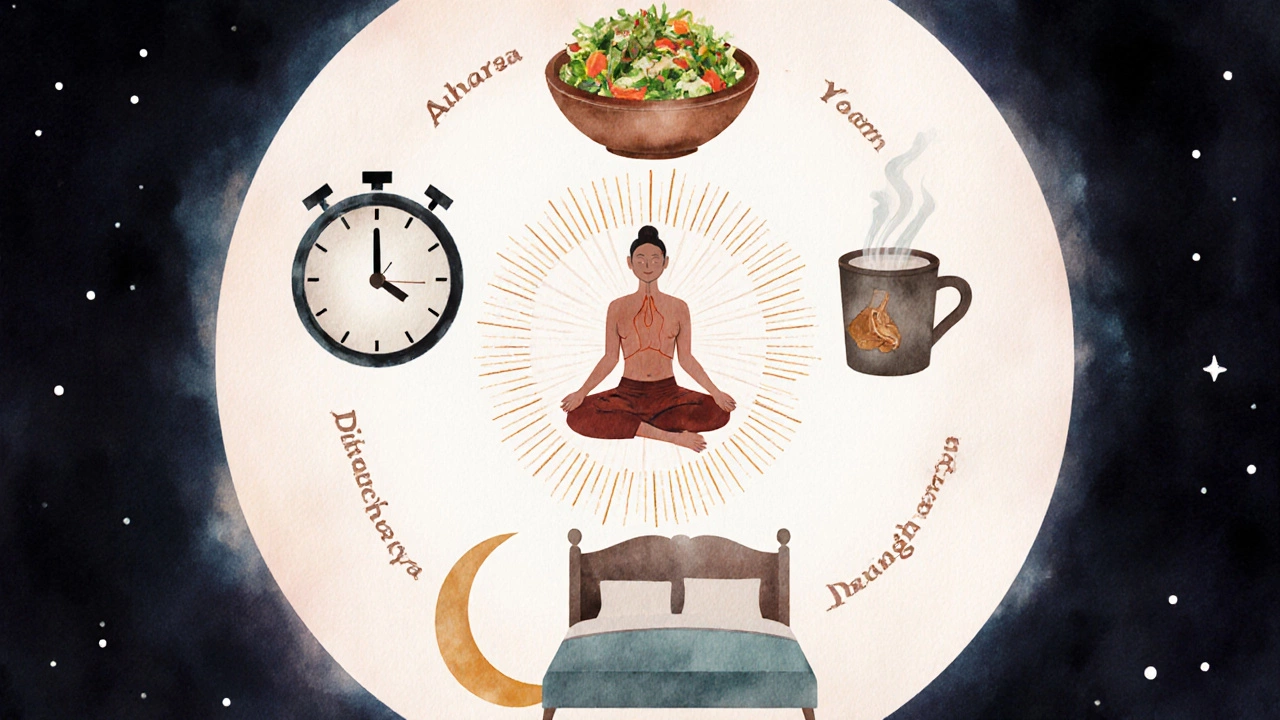Ayurvedic 80/20 Rule Calculator
Your Ayurvedic 80/20 Assessment
Find the habits that will create 80% of your health results with just 20% of your effort.
Your High-Impact Habits
VataYour 20% that creates 80% of results:
Key Takeaways
- The 80/20 rule in Ayurveda helps you focus on the most impactful habits for health.
- It aligns with the dosha concept by targeting the 20% of actions that balance 80% of your constitution.
- Practical tools like diet tweaks, routine shortcuts, and mindful breathing make the rule easy to apply.
- Small, consistent changes outperform exhaustive regimens in the long run.
- Using the rule can prevent burnout while still honoring core Ayurvedic wisdom.
When you hear “80/20 rule,” you might picture business charts or a productivity hack. In Ayurveda, the same principle is used to trim down complex lifestyle prescriptions into the few actions that truly shift your health. Instead of trying to overhaul every meal, every sleep pattern, and every ritual, you concentrate on the high‑impact tweaks that bring balance to your Dosha - the bio‑energetic forces Vata, Pitta, and Kapha that define your constitution. This approach resonates with modern life: busy professionals, parents, or students can still reap Ayurvedic benefits without feeling like they’ve joined a monastic order.
80/20 Rule in Ayurveda is a simplified framework that says roughly 20% of your daily choices drive about 80% of the health outcomes you experience. It isn’t a strict formula; it’s a mindset shift. By identifying the handful of habits that influence digestion, energy, and mood the most, you create a sustainable path to harmony.
Why the 80/20 Mindset Fits Ayurvedic Philosophy
Ayurveda has always emphasized balance, moderation, and personal adaptation. The ancient texts speak of Prakriti, the innate constitution each person is born with, and how small, consistent adjustments keep that constitution in equilibrium. The 80/20 rule mirrors this by suggesting that you don’t need to chase perfection in every area. Instead, you target the most potent levers - the ones that directly affect Agni, the digestive fire that fuels metabolism and immunity. When Agni is strong, the body processes food efficiently, toxins clear, and the doshas stay calm. Therefore, sharpening focus on Agni‑supporting habits aligns perfectly with the core Ayurvedic goal of sustaining health.
Pinpointing the High‑Impact 20%: Core Areas to Examine
Below are the main pillars where the 80/20 rule typically shows the biggest return:
- Diet (Ahara) - Choose foods that pacify your dominant dosha and support Agni. For most people, that means a few simple swaps rather than a full‑blown diet overhaul.
- Daily Routine (Dinacharya) - Consistent wake‑up, meal, and wind‑down times create rhythmic stability that the doshas love.
- Breathing & Mindfulness - Simple pranayama or a five‑minute meditation can calm Vata, cool Pitta, and ground Kapha.
- Sleep Hygiene - Aligning bedtime with the sun’s cycle (ideally 10 pm‑6 am) maximizes restorative repair.
- Hydration & Warm Beverages - Warm water with a pinch of ginger or cinnamon fuels Agni without over‑loading the system.
Each of these five pillars can be broken down into specific, actionable steps. The next section shows how to decide which steps belong to the critical 20% for you.
How to Identify Your Personal 20%
Start with a quick self‑assessment. Write down your current habits under each pillar and rate their impact on energy, digestion, and mood on a 1‑5 scale. Then, rank the habits by the scores. The top one or two entries in each pillar usually represent the 20% that will move the needle the most.
For example, if you notice frequent indigestion after coffee, that habit might rank a 5 for negative impact on Agni. Replacing coffee with warm herbal tea becomes a high‑impact change. If you already sleep at a decent hour but feel groggy, perhaps your wind‑down routine (screen time, heavy meals) is the culprit - another high‑impact tweak.

Applying the Rule: Sample Plans for Different Dosha Types
Below is a concise table that translates the 80/20 principle into concrete actions for each primary dosha.
| Dosha | High‑Impact Diet Swap (20%) | Key Routine Adjustment (20%) | Quick Mind‑Body Boost (20%) |
|---|---|---|---|
| Vata | Replace raw salads with lightly cooked veggies + ghee. | Set a consistent 7 am wake‑up, avoid skipping breakfast. | Practice 5‑minute alternate‑nostril breathing. |
| Pitta | Swap spicy fried foods for cooling cucumber‑mint raita. | Finish dinner by 7 pm, keep the kitchen cool. | Do 3‑minute Shitali breath (tongue‑cooling). |
| Kapha | Replace heavy dairy with warm soy milk plus turmeric. | Take a brisk 20‑minute walk after lunch. | Practice 5‑minute Kapalabhati (energizing breath). |
The table highlights that just three targeted moves-one per pillar-can deliver the bulk of the health benefit for each dosha type. You can stack additional tweaks later, but the 80/20 rule advises you to master these first.
Real‑World Stories: How People Used the 80/20 Rule
Sarah, a busy graphic designer in Melbourne, felt constantly fatigued. She logged her habits for a week and saw that irregular meals and late‑night scrolling were the top negative scores. By adopting two simple 20% actions-eating a warm oatmeal bowl with cinnamon every morning and turning off screens by 9 pm-her energy rose within ten days. Sarah didn’t overhaul her entire diet; she focused on the two high‑impact habits, proving the rule works outside a clinical setting.
Ramesh, a 45‑year‑old IT consultant in Bangalore, struggled with frequent heartburn-a classic sign of weak Agni. His self‑audit revealed heavy coffee intake and late‑night snacking as the worst offenders. He replaced coffee with ginger‑lemon tea and set a 7 pm cut‑off for food. Within three weeks, his heartburn subsided, and he reported better sleep. Ramesh’s story highlights that the 80/20 rule can target specific dosha imbalances (in his case, aggravated Pitta) effectively.
Common Pitfalls and How to Avoid Them
- Thinking 80/20 means “do nothing else.” It’s a prioritization tool, not an excuse to ignore other healthy habits.
- Choosing the wrong 20%. Use a simple scoring system; don’t guess which habit feels important.
- Neglecting seasonal changes. Ayurvedic guidance shifts with the seasons; revisit your list quarterly.
- Skipping professional input. If you have chronic conditions, a qualified Ayurvedic practitioner can validate your high‑impact choices.

Integrating the 80/20 Rule with Full Ayurvedic Practice
Think of the 80/20 rule as the starter engine that gets you moving. Once you’ve built momentum, you can layer additional Ayurvedic practices-herbal supplements, oil massages (Abhyanga), or detox protocols-without feeling overwhelmed. The rule essentially creates a safety net, ensuring that the core of your routine stays strong even as you explore deeper therapies.
Quick Checklist: Your First 80/20 Ayurvedic Jump‑Start
- Identify your dominant dosha (Vata, Pitta, or Kapha).
- List daily habits under diet, routine, sleep, breath, hydration.
- Score each habit 1‑5 for impact on energy, digestion, mood.
- Select the top 1‑2 habits from each category (the 20%).
- Implement those changes for two weeks, track results.
- Adjust scores and repeat the cycle.
Mini FAQ
Is the 80/20 rule a traditional Ayurvedic concept?
The exact wording isn’t found in classical texts, but Ayurvedic teachers have long urged practitioners to focus on the most balancing actions. Modern teachers borrowed the Pareto idea to make that advice more concrete.
Can I apply the rule if I have a mixed dosha?
Yes. Identify the dominant dosha at any given time (season, stress level) and prioritize habits that calm that dosha. You may end up with a hybrid list that covers both Vata‑balancing and Pitta‑soothing actions.
Do I need to track everything obsessively?
No. A simple notebook or phone note works. The goal is awareness, not perfection. Record only the habits you’re testing as part of the 20%.
How long before I see results?
Most people notice improved digestion and steadier energy within 7‑14 days, especially if the changes target Agni directly.
Is the 80/20 rule compatible with Ayurvedic herbs?
Absolutely. Once your core habits are stable, adding a handful of herbs (like ginger for Vata or neem for Pitta) amplifies the benefits without adding complexity.
By zeroing in on the few actions that truly matter, you honor the Ayurvedic goal of living in harmony with nature-without getting lost in a sea of dosha‑specific rules. Give the 80/20 rule a try for two weeks, track the shift, and you’ll likely find a smoother, more sustainable path to wellbeing.
